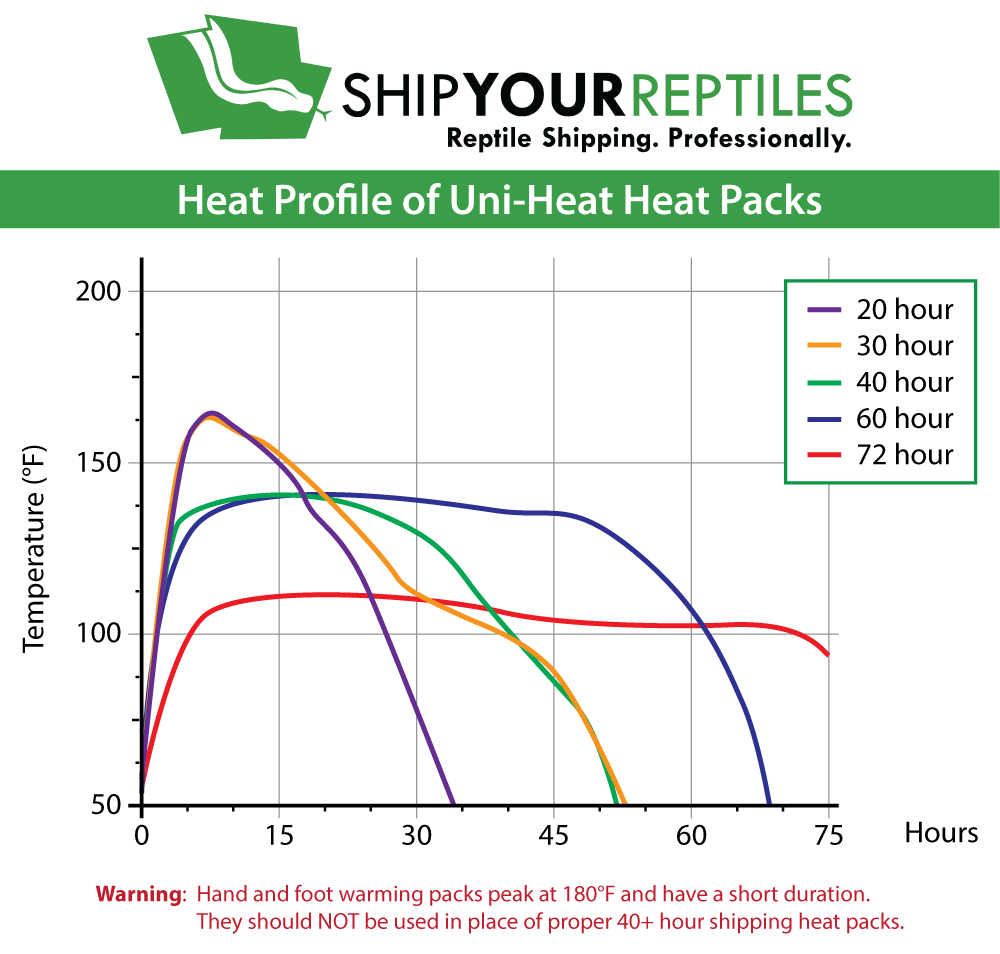ShipYourReptiles.com offers 40- and 72-hour heat packs.
40-hour heat packs are most often used for reptile shipping. Reptiles must be shipped Priority Overnight, and the 40-hour heat pack is appropriate. Heat packs of less than 40-hour duration do NOT meet the SYR Shipping Standards.
To ship live reptiles, do not use 12- or 24-hour packs available at local BigBox stores or ski shops. These packs are hand warmrs, not shipping tools. 12- and 24-hour packs DO NOT provide the necessary heat nor duration for a successful live shipment. These also peak at a much higher temperature than shipping heat packs (180F) and endangure the life of live shipments.
Heat packs work through a chemical reaction between the contents of the heat pack and oxygen in the surrounding air. Oxygen flow is regulated through the perforated red line. Never cover the red line with tape or anything else.
Pre-start your heat pack two hours before shipping.
Shake it up well and place it in a folded towel so it can generate a quick, solid heat.
The heat pack will not heat up properly if you leave it in open air.
The heat pack must be well started before you tape it to the underside of the top insulation panel and seal your box. Do not tape over the perforated red line. The red line should face the interior of the box.
Notes:
Do not overuse heat packs!
Use only one heat pack per box unless you are using our largest box, the 30"x16"x10", where two heat packs can be used if needed.
Two heat packs in a box 16x16x8 or smaller will cause the box to get too hot and can kill the animal.
In a small or medium sized box, multiple heat packs will increase the ambient temperature of the box into dangerous territory.
Review the chart below for the temperatures that a single heat pack puts out. More is absolutely not better, just much, much hotter.
The purpose of a heat pack is NOT to warm or heat the box, it is to prevent it from getting cold. You want a temperate box, NOT a hot box!
If the temperatures are near the lower end of the SYR guidelines, doubling the insulation or having the shipment held at a FedEx facility will minimize the chances for a DOA.
DOAs are often caused by improper use of heat packs during the winter. Using too many heat packs in a box can cause the inside of the box to overheat.Heat packs use oxygen and using more than needed may consume all the oxygen in the box and have fatal consequences for the animal.
6 Critical Points for Heat Pack Use
1. Heat packs should never come into direct contact with the animal bag/container.
2. There should always be crumpled newspaper or other packaging material between the heat pack and animal bag/container.
3. Heat pack should never be placed under an animal bag/container, as it will result in high likelihood of DOA.
4. Heat pack should be taped securely to underside of the styrofoam lid. DO NOT cover the red stripe with tape!
5. Failure to comply with the above points will INVALIDATE Live Arrival Insurance.
6. Lastly, we do not recommend heat pack use in any box smaller than the 12x9x6. If you need a heat pack with your shipment, you should use the 12x9x6 box or larger.
Note: New heat packs are soft and feel like loose powder. Used heat packs are hard. If your heat pack is hard, it has been compromised. Use a new one.
Chart of heat pack surface temperatures for the various heat pack sizes:

NOTE – The following non-compliance of heat-pack use will INVALIDATE any SYR Insurance:
Use of hand-warmers, foot-warmers, or any heat pack with less than 40-hour duration.
Use of more than one heat pack in any box smaller than our #5 size.
Failure to provide specific ventilation (four quarter-inch holes, two at each end of the box).
Placing the heat pack at the bottom of the shipping box and/or in direct contact with the animal or the container for the animal
Attaching the heat pack facing the wrong way or covering the red stripe with tape.